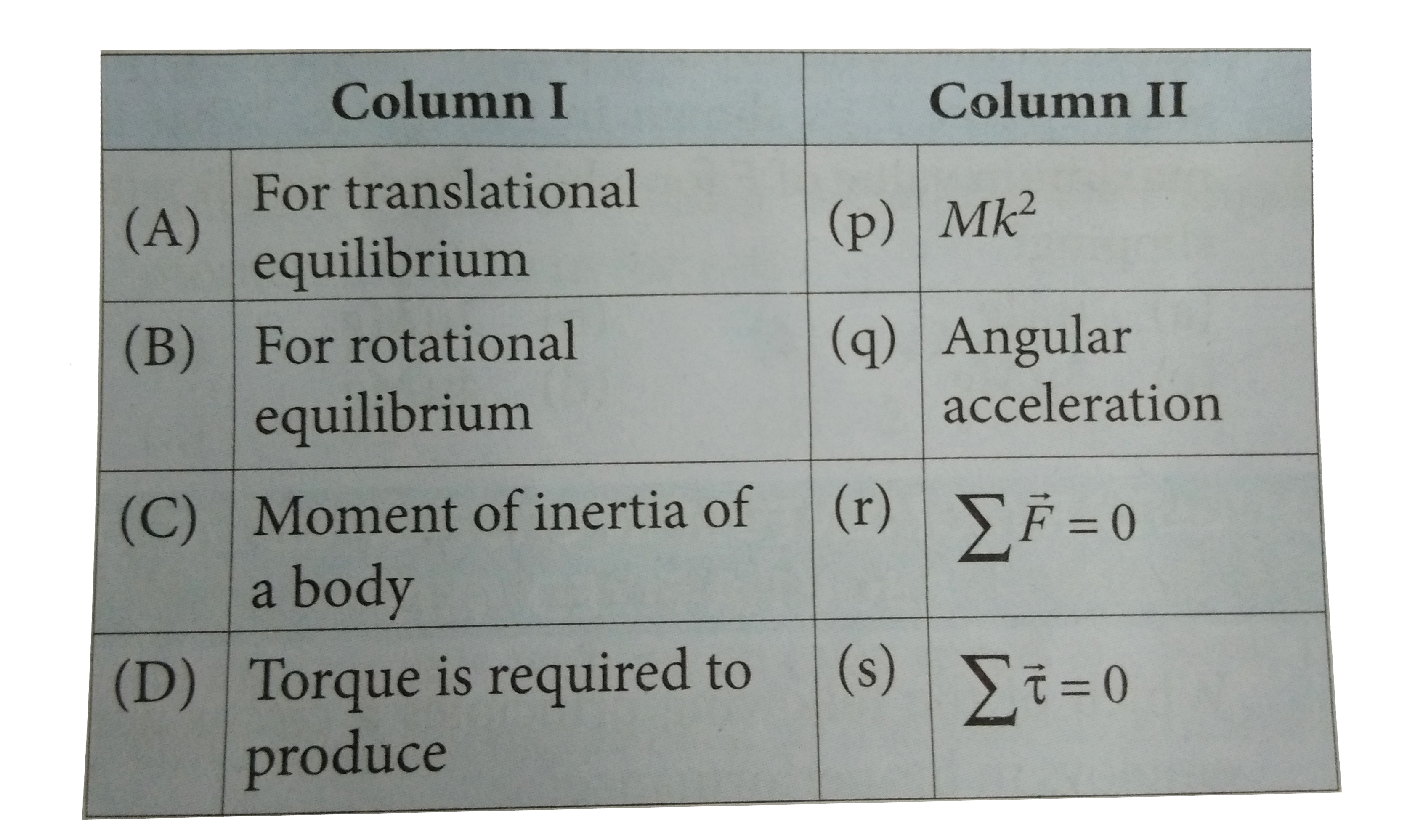Match the column
Column−IColumn−II(Solid)(Examples)(a)Covalent(P)SiO2(b)Molecular(Q)CaO(c)Ionic(R)CCl4(d)Metallic(S)Bronze
(a)P (b)Q ( c)R (d)S
(a)R (b)P (c )Q (d)S
(a)S (b)P ( c)Q (d)R
(a)P (b)R (c )Q (d)S
The correct Answer is:D
To solve the problem of matching the columns, we will analyze each type of solid in Column-I and find the corresponding example in Column-II.
1. Identify Covalent Solids:
- Covalent solids consist of non-metal atoms bonded together by covalent bonds, forming a network structure.
- Example: Silicon dioxide (SiO₂) is a well-known covalent solid.
- Match: (a) "Covalent" → (P) SiO₂
2. Identify Molecular Solids:
- Molecular solids are composed of molecules held together by intermolecular forces (like van der Waals forces).
- Example: Carbon tetrachloride (CCl₄) is a molecular solid.
- Match: (b) "Molecular" → (R) CCl₄
3. Identify Ionic Solids:
- Ionic solids are made up of ions held together by strong electrostatic forces of attraction.
- Example: Calcium oxide (CaO) is an ionic solid.
- Match: (c) "Ionic" → (Q) CaO
4. Identify Metallic Solids:
- Metallic solids consist of metal atoms that are bonded by metallic bonds, with a sea of delocalized electrons.
- Example: Bronze, which is an alloy primarily made of copper and tin, is a metallic solid.
- Match: (d) "Metallic" → (S) Bronze
Final Matches:
- (a) "Covalent" → (P) SiO₂
- (b) "Molecular" → (R) CCl₄
- (c) "Ionic" → (Q) CaO
- (d) "Metallic" → (S) Bronze
Summary of Matches:
- (a) → (P)
- (b) → (R)
- (c) → (Q)
- (d) → (S)
- Covalent solids consist of non-metal atoms bonded together by covalent bonds, forming a network structure.
- Example: Silicon dioxide (SiO₂) is a well-known covalent solid.
- Match: (a) "Covalent" → (P) SiO₂
- Molecular solids are composed of molecules held together by intermolecular forces (like van der Waals forces).
- Example: Carbon tetrachloride (CCl₄) is a molecular solid.
- Match: (b) "Molecular" → (R) CCl₄
- Ionic solids are made up of ions held together by strong electrostatic forces of attraction.
- Example: Calcium oxide (CaO) is an ionic solid.
- Match: (c) "Ionic" → (Q) CaO
- Metallic solids consist of metal atoms that are bonded by metallic bonds, with a sea of delocalized electrons.
- Example: Bronze, which is an alloy primarily made of copper and tin, is a metallic solid.
- Match: (d) "Metallic" → (S) Bronze
- (a) "Covalent" → (P) SiO₂
- (b) "Molecular" → (R) CCl₄
- (c) "Ionic" → (Q) CaO
- (d) "Metallic" → (S) Bronze
- (a) → (P)
- (b) → (R)
- (c) → (Q)
- (d) → (S)
Topper's Solved these Questions
- CHEMISTRY AT A GLANCEBOOK - ALLENCHAPTER - CHEMISTRY AT A GLANCEEXERCISE - ORGANIC CHEMISTRY
472 Videos
- CHEMISTRY AT A GLANCEBOOK - ALLENCHAPTER - CHEMISTRY AT A GLANCEEXERCISE - ORGANIC CHEMISTRY
472 Videos
- Chemical EquilibriumBOOK - ALLENCHAPTER - Chemical EquilibriumEXERCISE - All Questions
30 Videos
- ELECTROCHEMISTRYBOOK - ALLENCHAPTER - ELECTROCHEMISTRYEXERCISE - EXERCISE -05 [B]
38 Videos
Similar Questions
Knowledge Check
Match the Column I and Column II.,B
 AA-p, B-q, C-r, D-sBA-q, B-r, C-s. D-pCA-r, B-q, C-p, D-pDA-r, B-s, C-p, D-q
AA-p, B-q, C-r, D-sBA-q, B-r, C-s. D-pCA-r, B-q, C-p, D-pDA-r, B-s, C-p, D-q
Match the column
Column−IColumn−II(a)C2H2(P)sp3dhybridisationSO2(Q)sp3hybridisation(c)I−3(R)sp2hybridisation(d)NH+4(S)sphybridisation
View SolutionMatch the column-I and column-II
Column-IColumn-II(i)Agaricus(a)Ascomycetes(ii)Colletotrichum(b)Deuteromycetes(iii)Albugo(c)Phycomycetes(iv)Neurospora(d)Basidiomycetes
View SolutionMatch the Column I with Column II.
Column IColumn II(Plant)(Vegetative reproduction by )(a)Turmeric(i)Stolon(b)Crocus(ii)Rhizome(c)Vallisnerla(iii)Aerial shoot(d)Opuntia(iv)Corm
View SolutionMatch the ores (column I) with the metals (column II):

View SolutionMatch the column I with column II
Column-IColumn-II(A)Starch(p)Natural polymer(B)Nylon-6(q)Synthetic polymer(C)Peptide Bond(r)Amide linkage(D)Maltose(s)Glycoside linkage(t)Oligosaccharide
View SolutionMatch the Column-I with Column-II :
Column-IColumn-II(a)Mole fraction(p)mol kg−1(b)Molality(q)Depends on temperature(c)Molarity(r)Unitless(d)Normality(s)Independent of temperature
View SolutionMatch the following column I with column II and choose the correct combination.
ColumnIColumnII(a)Earthworm(i)Gizzard(b)Cockroach(ii)Caecum(c)Frog(iii)Clitellum(d)Rat(iv)Cloaca
View Solution
